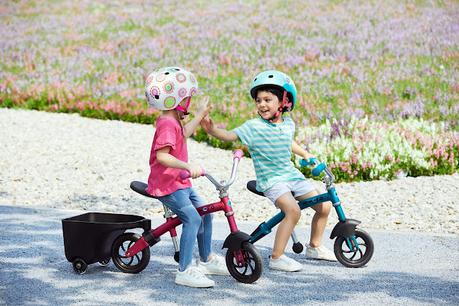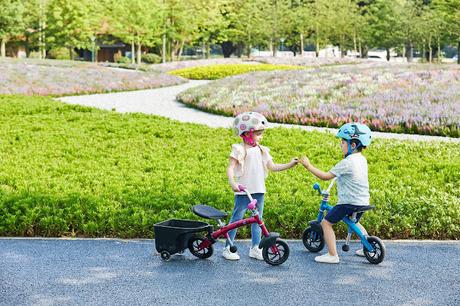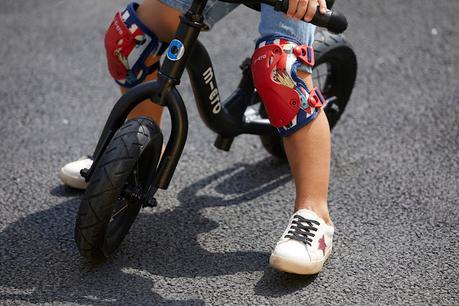
With Christmas just around the corner, many parents are making the decision on the right bike for their children and with so many different types on the market it can be quite an overwhelming choice to make.
To help you narrow down your choices, I'm sharing some insight and tips on balance bikes which have fast become one of the most popular choices for children.
What Is A Balance Bike?
In simple terms, a balance bike is a bike without pedals. It looks and moves exactly the same as a traditional bike in every sense other than the fact that is has no pedals. In order to move forwards, kids simply need to push themselves with their feet - in exactly the way most kids naturally do when first using a traditional bike!
This natural movement can help children to feel confident and comfortable when riding, and as balance bikes don't use stabilisers/training wheels they can be really beneficial in helping children to find their center point when riding and develop natural balance and co-ordination. Then when they feel confident in balancing, they can progress to using a pedal bike.
Is A Balance Bike The Right Choice For My Child?
If your child is just starting out as a bicycle user or has had some trouble with using a pedal bike, then a balance bike is likely to be a good choice for you. The ideal age for a child to start using a balance bike is between 18 months-2 years old as this is when children are usually developmentally ready for it, however all children differ and older children can also benefit from balance bikes - particularly if they're not feeling confident with pedal biking. Balance bikes provide great exercise and are really fun to use, so all children will benefit from using them.
What's The Best Age To Start Using A Balance Bike?
As mentioned above, children tend to be developmentally ready for bicycles between 18 months-2 years but all children are different so its important to see this as a guideline rather than a steadfast rule.

Pros & Cons Of Balance Bikes
This is the question that most parents struggle with, how to decide between a traditional pedal bike or a balance bike? Let's take a look at some of the selling points of balance bikes...
*They are known to improve co-ordination and strength as well as improving confidence more quickly than traditional pedal bikes*Less overwhelming for children as the ability to propel forward using the feet comes more naturally than the ability to pedal*No need for stabilisers/training wheels which can actually make it difficult for children to learn how to balance independently, and can also be difficult to use on sloped ground as they can cause tipping.*No chain which reduces the risk of injury*Balance bikes tend to be lower to the ground, which means less distance for potential falls as well as being less intimidating for small children*Less chance of high speed crashes as balance bikes can only go as fast as your child can push*They tend to be smaller and lighter, meaning they're easier for parents to carry if kids get bored!
So what about the cons?
With so many models on offer now, the previous cons of expense and lack of choice have largely been removed leaving the only real con - that children may outgrow them and prefer to move on to a pedal bike quickly. However this is not a given as many children do prefer to stick with balance bikes. It's also worth considering that the resale market for used balance bikes is always good, so as long as your bike is kept in good condition you're unlikely to be stuck with it once your child has moved on.
How To Find The Right Balance Bike For Your Child
With so many balance bikes now on the market, choosing the right one can be tricky. The main points to consider when making your choice are:
*Size - The sizing of balance bikes is a little different from traditional pedal bikes, which are based on wheel or frame size. To find the right size for your little one, the trick to measure their inside leg and ensure that the minimum height of the bike's saddle is the same size as this. If your child's inside leg measurement is longer than the height of the saddle, you need to choose a larger bike. You should also ensure that they can comfortably reach the handle bars when sitting on the bike.
*Weight - Try to choose as light a bike as possible as the lighter the bike, the easier it will be for your child to propel themselves forward on it. Although wooden bikes can be very light and look very cute, try to choose one that won't warp when wet.
*Design - Speaking from personal experience, one thing not to forget is your childs preferences when it comes to a bike as a child who doesn't like the color or design of their bike will be far less excited to learn how to use it! If possible, get your child involved in choosing their new bike as this will help to encourage them to get excited about using it. If this isn't possible, keep their color and style preferences in mind when choosing the bike.

Tips For Getting Started With Your Balance Bike
Once you've made your choice, there are a few things to remember on your first outing.
*Don't forget the helmet - a balance bike is no different to any other bike when it comes to the risks of head injury, so wearing a helmet is vital. Luckily there are lots of cute helmets on the market which make it fun for kids to wear. It's also worth considering knee and elbow padding too, as injuries early on can impact a child's desire to keep practicing.
*Pick a safe location - Be sure to choose somewhere free from traffic and crowds for your fast practice, and without too many distractions. Tarmac and short grass are ideal, away from steps, water or parked cars.
*Practice makes perfect - Some children can struggle to maintain motivation to learn if they don't get the knack of something right away, but try to encourage regular practice as it can take a little while to master balance and co-ordination. Using fun accessories like streamers, bells, stickers, trailers or dolly seats can all encourage children to want to keep trying.
I hope this article has been helpful in making a decision on your which bike is best for your child. Happy cycling!
If you enjoy my blog, please consider following me on Bloglovin'
